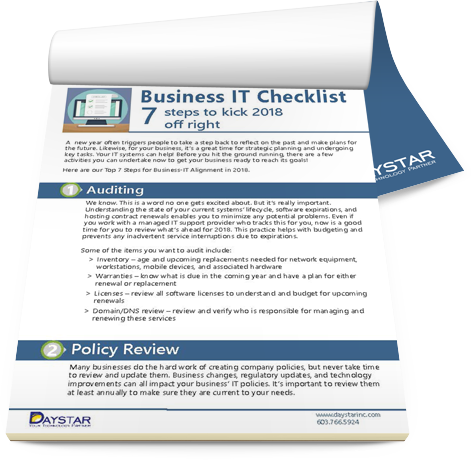Small and mid-sized businesses (SMBs) today are increasingly becoming prime targets for cybercriminals. According to a report by Verizon, 43% of cyberattacks are aimed at SMBs, exploiting their often limited security infrastructures. This alarming trend underscores a pressing issue: many SMBs underestimate the importance of robust network security.
Cybersecurity is no longer a luxury; it's a necessity for survival in the modern business landscape. - Keith Bamford, CEO of Daystar.
Understanding network security threats and vulnerabilities is the first step in fortifying your business against potential breaches. Let's delve into the common threats and how to safeguard your organization effectively.
1,000+ Endpoints Protected & 25+ Years Securing SMBs
Experience what it’s like to have enterprise-grade network protection tailored for growing businesses like yours.
Understanding Network Security Threats
Business networks face an expanding catalogue of threats that go far beyond the headline‑grabbing ransomware outbreaks. According to the 2024 Verizon Data Breach Investigations Report, exploitation of vulnerabilities as an initial point of entry nearly tripled, now accounting for 14% of all breaches. This sharp rise signals that threat actors are increasingly targeting overlooked weaknesses in systems rather than relying solely on social engineering.
What does this mean for small and mid-sized businesses (SMBs)? It means even a single unpatched application or misconfigured device can serve as a red carpet for attackers. And while large enterprises often have entire departments dedicated to closing these gaps, SMBs must protect themselves with limited resources—making awareness and prioritization even more critical. Meanwhile, 60% of small companies that get hit by a cyber attack go out of business within six months.
Let’s explore the types of network security threats that you’re most likely to face—and how each one works to compromise your business.
|
Threat |
How it Works |
Why It Hurts SMBs |
First‑Line Defense |
|
Malware Attacks (viruses, worms, ransomware) |
Malicious code infiltrates endpoints or servers, encrypts or exfiltrates data, then demands payment. |
Average breach recovery now tops US $4.88 million. |
Next‑gen endpoint protection, immutable backups, tested recovery playbooks. |
|
Phishing Scams |
Socially engineered email or SMS lures staff into divulging credentials or downloading malware. |
90% of breaches begin with a phish; SMB staff wear many hats and click in haste. |
Real‑time email filtering, ongoing phishing simulations, security‑awareness nudges. |
|
Denial‑of‑Service (DoS) & DDoS |
Flood servers or edge devices with bogus traffic until legitimate users are locked out. |
Even a one‑hour outage can paralyze e‑commerce and erode customer trust. |
Cloud‑based DDoS scrubbing, redundant bandwidth, and rate‑limiting on firewalls. |
|
Supply‑Chain & Third‑Party Exploits |
Attackers compromise a trusted software update or MSP tool, then pivot into your environment. |
Outsourced IT is essential for growth, but inherited risk is often uncharted. |
Vendor risk assessments, software‑bill‑of‑materials (SBOM), and zero‑trust segmentation. |
Common Network Vulnerabilities in SMBs
Weaknesses—vulnerabilities—are the cracks attackers prize open. A staggering 40,187 new common vulnerabilities and exposures (CVEs) were published in 2024 alone, up 39% year‑on‑year.
|
Vulnerability |
Real‑World Impact |
Rapid‑Fix Checklist |
|
Outdated Software & Firmware |
Unpatched Exchange servers were the initial foothold in over 2,000 breaches last year. |
Auto‑patch policies, test‑dev staging, subscription to vendor security bulletins. |
|
Weak or Reused Passwords |
3 in 10 IT pros admit a breach tied to flimsy credentials. |
Enforce 12‑character minimums, breach‑password screening, and passwordless options. |
|
Misconfigured Firewalls |
Gartner warns that “99% of firewall failures stem from misconfigurations, not flaws.” Capital One’s 2019 breach is Exhibit A. |
Rule‑set reviews, change‑control workflows, automated config validation tools. |
|
Flat Networks & Open Ports |
Attackers who land on one endpoint can traverse the entire LAN. |
VLAN/segmentation, zero‑trust micro‑perimeters, disable unused services. |
|
Shadow IT & BYOD |
Unvetted SaaS and rogue devices create blind spots in logging and monitoring. |
Formal app‑approval processes, MDM/EMM for mobile assets, CASB for SaaS. |
Action step: Run a quarterly network‑penetration test capped by a plain‑English briefing for executives—no jargon, just clear risk‑impact‑cost equations.
The Human Element — Insider Threats & Social Engineering
Technology rarely fails alone; people help it along. The 2024 Insider Threat Report pegs collusion or careless insiders in 55% of incidents, with a median cost of US $642k for SMBs.
- Malicious insiders leverage legitimate access to siphon proprietary data.
- Negligent insiders click the wrong link, misroute emails, or ignore update prompts.
- Compromised insiders have their identities hijacked by external attackers.
Reduce the blast radius:
- Least‑Privilege & Just‑In‑Time Access – nobody keeps standing admin rights.
- User‑Behavior Analytics (UBA) – flag impossible travel, off‑hours logins, bulk downloads.
- Live‑Fire Phishing Drills – monthly, not yearly, with instant micro‑learning moments.
- Transparent Culture – reward rapid reporting; banish blame to surface issues earlier.
For deeper guidance, CISA’s Insider Threat Mitigation Guide provides an excellent framework.
Proactive Measures to Mitigate Risks
Staying ahead of cyber threats means shifting from a reactive stance to a proactive security culture.
It’s not about waiting for something to go wrong; it’s about assuming that if you haven’t been targeted yet, you will be soon. Here's how small and mid-sized businesses like yours can level the playing field:
Start with Regular Security Audits.
Security audits aren’t just IT checklists; they’re your frontline defense against silent gaps. They help uncover everything from forgotten devices still connected to the network to inactive accounts with administrative privileges.
By running audits quarterly or after major changes, you get ahead of configuration drift and outdated policies. Use established frameworks like CIS Controls to guide these reviews.
Implement Multi-Factor Authentication (MFA).
Credential theft remains one of the easiest ways attackers breach networks. Multi-Factor Authentication, especially app or token-based rather than SMS, adds an essential roadblock.
According to Microsoft, MFA can prevent over 99% of account compromise attacks. Every critical system in your business, including email, remote access, and cloud storage, should have MFA turned on, with no exceptions.
|
Get More Strategic IT Advice at Our Learning Center |
Encrypt What Matters
Encryption is your data’s invisibility cloak. If your files are intercepted, they’re unreadable without the key. This applies to both “data at rest” (on your servers or laptops) and “data in transit” (emails, file transfers, etc.).
Enable full-disk encryption for company laptops, ensure your email provider supports TLS, and use encrypted backups that can’t be tampered with once written.
Patch Fast and Often
Cybercriminals love predictable patterns. When a new software vulnerability is announced, they race to exploit systems before businesses apply patches.
Automating your patch management, especially for critical systems, can close the window of opportunity. Aim for a 48-hour turnaround on critical updates and test them in staging before pushing live.
Document Your Incident Response Playbook
No business is immune from incidents—it’s how you respond that counts. A documented playbook outlines exactly who does what, when, and how. It eliminates confusion in high-pressure situations.
Include key contacts, decision trees, reporting protocols, and recovery procedures. Then, test it. Tabletop exercises twice a year can reveal weak spots and build muscle memory across your team.
Bring in Expert Backup
Working with a Managed Service Provider (MSP) like Daystar can provide an immediate upgrade to your cybersecurity posture.
MSPs offer 24/7 monitoring, advanced threat detection, and access to specialized security tools that might be cost-prohibitive on your own. They stay on top of evolving threats so you don’t have to, turning security into a strategic advantage, not just a defensive expense.

Partner with Daystar—Lock Down Your Network Before Threats Strike
Cyberattacks are no longer just a risk—they're a certainty. And as you've seen, the most devastating breaches often stem from common network vulnerabilities, unchecked insider threats, and outdated security practices. But you don’t have to navigate this evolving threat landscape alone.
By understanding the threats, addressing the weak points, and implementing proactive security measures, you can shield your business from costly disruptions and reputational damage. The smartest SMBs are moving from reactive to resilient—and that shift starts with the right partner.
Daystar is your trusted ally in building a secure, future-proof IT environment. With our expertise in managed IT and cybersecurity, we help you stay ahead of threats, close security gaps, and focus on growth—not firefighting.
Ready to take control of your cybersecurity? Contact Daystar today to schedule a consultation and discover how our Managed IT Services can protect your business from the inside out.
|
Discover The Difference That New England’s Top IT Consultants Can Make |
|||












